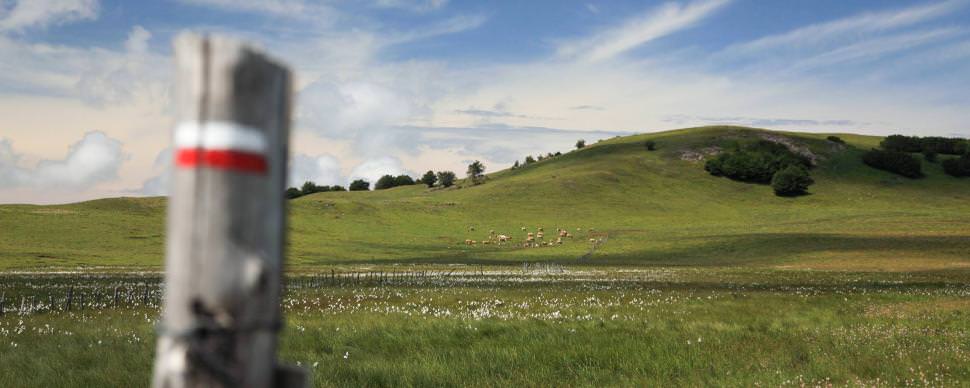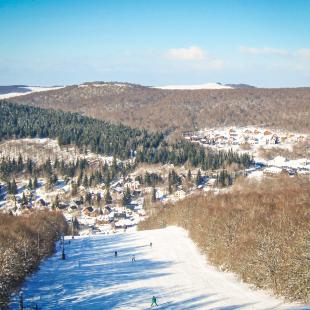Top 12 Aubrac in Aveyron
touristic guide

Great spaces of the Aubrac
Forests and pastures spread out over 2500km². After the transhumance, that marks the start of the summer, you come across herds of magnificent Aubrac breed cows around the innumerable shepherd's mountain shelters called “burons”.
This is where your senses will be stimulated while crossing the magical landscape, where the constantly changing light sculpts the contours and rocks creating a unique ambiance.
In winter, snow transforms this unique steppe into a beautiful Nordic zone where cross-country and alpine skiers enjoy the great expanses.
La Dômerie d’Aubrac
Founded in 1120, la Dômerie d’Aubrac was a “refuge hospital” for pilgrims en route towards Saint Jacques de Compostelle. Today, some major vestiges remain of this ensemble: Notre Dame church, the hospital and the Tour des Anglais. Aubrac, a mythical place heavily marked by history, is listed as a Historic Monument.
On the Chemins de Saint Jacques de Compostelle, (GR65 from Puy-en-Velay) it is classed by UNESCO as World Heritage and by the European Council as a Cultural Itinerary. For those who wish to walk in the footsteps of pilgrims, the section Nasbinals-Aubrac-Saint-Chély d’Aubrac (17km) is classed as natural heritage by UNESCO, within the framework of the Chemins de Compostelle, for its authenticity and landscape.

the stars of the Aubrac

A knife with a famous destiny
Symbol of the Aveyron, the Laguiole knife is known the world over. The living and dynamic knife making activity is a reality in the village where you will find numerous boutiques and workshops. Laguiole can really claim the authenticity and savoir-faire of this work of art.
Laguiole, the village
The granite and basalt houses with their lauze covered roofs surround the imposing bronze statue of the bull, symbolic expression of the placid force, the ardour and the vigour of the Aubrac breed bull.
Knife makers can be visited and traditional local products tasted. The village is an ideal base both in winter for enjoying the local ski resorts and in summer for rural tourism.


Laguiole, the cheese
Cheese has traditionally been made on the Aubrac for a very long time, monks from La Dômerie were already making it in the 12th century. Today, the "Jeune Montagne" cooperative collects milk from the region to make tome de Laguiole which benefits from an AOC (appellation d'origine contrôlée).
It is with this same tome fraîche that aligot is made.
Exceptional fauna and flora
Walking in the area, you can’t help but appreciate the plateau’s exceptional fauna and flora. It is one of the richest flora in Europe, with more than 1000 species, from the most common, such as yellow gentian or Aubrac tea, to the more rare such as “drosera”, a carnivorous plant, that covers the plateau in summer. In spring, the fields are carpeted with yellow daffodils and narcissus.
The fauna also includes numerous species: roe deer, wild boar, foxes and red deer that you can hear rutting in the heart of the Aubrac forest in autumn.


Aligot, the traditional dish of the Aubrac
The Aubrac’s traditional and unique dish, aligot, is based on mashed potatoes to which are added tome de Laguiole and crème fraîche that give it a creamy and smooth texture. It is a real feast for your eyes and your stomach !
Where to taste it?
You will of course be able to taste aligot just about anywhere on the Aubrac, most restaurants offer it. But for an authentic experience, taste it in a buron
The Transhumance: take part in the festival
Participate in this traditional festival on the Aubrac. At the end of May, after the snow has melted, herds of cows are led to the summer pastures. They are adorned with flowers, plumes, ribbons etc. for a forty or so kilometre climb up to the Aubrac plateau.
You can accompany cows all along the route, take part in the festivals in the villages, enjoy the local markets, milking demonstrations, local gastronomy, decorated herds, folklore…

TO GO
further




